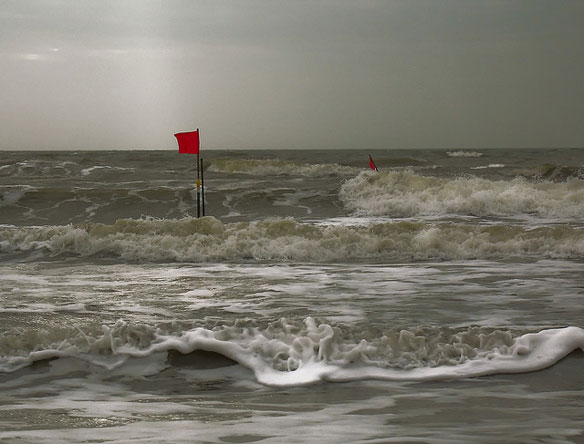
Photo source: ©© Dans Le Grand Bleu
Excerpts, by Woods Holes Oceanographic Institution, WHOI
The pollution that causes beach closures and illness in humans comes from many different places on land, but ultimately gets into the water primarily through one of two pathways—discrete point sources and diffuse non-point sources.
Point sources are single, identifiable inputs of polluted water that can often be monitored or controlled because they are readily identifiable. These generally include pipes or culverts pouring pollution directly into the water from a home or business. Non-point sources are diffuse flows passing over or through land (which might contain the pollution) before entering a water body. These are more difficult to detect, monitor, and control because they tend to be more variable, are often spread out over wide areas, and often invisible.
Many of the most common pollutants come from one of two places: humans and animals. Human fecal matter in water bodies constitutes the greatest public health threat because humans are reservoirs for many bacteria, parasites, and viruses that are dangerous to other humans and can cause a variety of illnesses. Residential buildings are a primary source of many of these pathogens, and the cause of many problems can often be traced back sewage overflows or leaky residential septic systems.
Runoff from agricultural land is also a serious health concern. Animal fecal waste may contain pathogens such as Cryptosporidium, or Salmonella. Likewise, pet waste can pose health threats to humans. A single dog feces contains more than 40 million enterocci bacteria (an indicator of other, more serious pathogens) and is equivalent to nearly 7,000 bird droppings.
Water running off of nearby land is often a major source of problems and pollution that closes urban beaches. Even a moderate rain can send enough water storm drains to overwhelm older “combined sewer systems” that mix runoff and sewerage. When a rainfall adds enough extra water to the system that the treatment plant cannot process everything fast enough and the excess, untreated water to flows into a nearby river, lake, or coastal area. That is why many beach closures occur after rainstorms—and why many municipalities now close beaches in advance of heavy rain.
Runoff from fields, lawns, parking lots, and streets can also wash directly into nearby waterways when it rains, carrying with it any pollutants that might have been on land. Even watering a lawn or washing a car can carry potentially harmful pathogens into the water. Leaky or malfunctioning septic systems, too, can cause potentially harmful pollution to seep slowly through the ground and into nearby lakes, rivers, and streams…
In addition to disrupting a day at the beach, water pollution poses a serious health threat to beachgoers. The most common illness arising from contact with polluted beach water is gastroenteritis, an inflammation of the stomach and the intestines that can result in vomiting, diarrhea, cramps, and fever. Other minor illnesses include rashes and infections of the ear, eye, nose, and throat…









